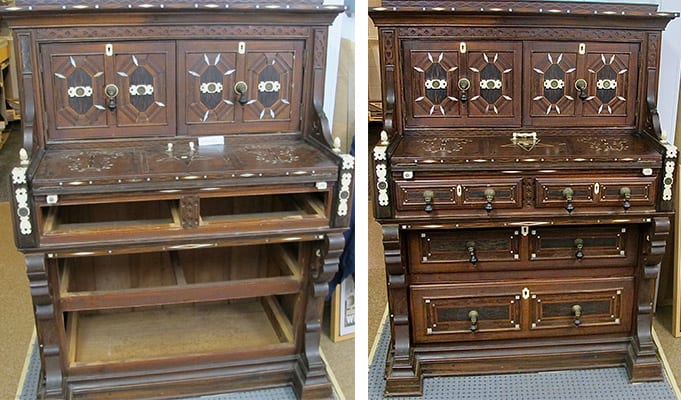Conservation Spotlight: Scrimshaw Desk

The Museum has a vast collection of inlayed scrimshaw. Keeping such “mixed-media” objects intact is challenging. Each type of material reacts differently when exposed to climatic fluctuations, and aging glues eventually lose their strength.
The swelling and contraction of different materials at different rates of time means that pieces get squeezed, pushed, or ejected from the object over time. Scrimshaw enthusiast and craftsman Jim Vaccarino has been restoring the inlay on dozens of pieces and, on a good number of occasions, he has had to fashion new pieces of inlay to replace those that have been lost.
The most challenging project Jim has undertaken to date has been the recently completed Eastlake style secretary desk made by Captain Charles Henry Turner (ODHS #2009.16). Standing over four feet tall, this monumental desk is among the largest and most elaborate scrimshaw pieces in the Collection. It is made primarily of mahogany with inlay of other exotic woods, mother of pearl, brass, and whalebone. The clever construction includes concealed secret compartments.
According to family lore, it was built over a four year period while Captain Turner was master of the New Bedford whaling bark A. R. Tuner on an Atlantic voyage and made from “floating wood” picked up in the ocean. The desk is said to have been completed on St. Helena, July 4, 1886 – a date that coincides with the birth of his first son, Reginald – in the house where Napoleon Bonaparte died. The desk was passed to Reginald who married in 1918.
According to a 1986 letter from his wife Teresa Turner Frawley, “The two doors that open in front have buttons from his wife’s wedding dress inserted with small pieces of ivory and pearl. It opens with carved whales teeth and elephant tusks. Acorns carved by hand make the decoration.”
After Reginald died in 1919, Teresa took care of the desk for 67 years until passing it down to her daughter whose family donated it to the Museum’s permanent collection in 2009. After nine years, we are pleased to have brought it back to displayable condition.

